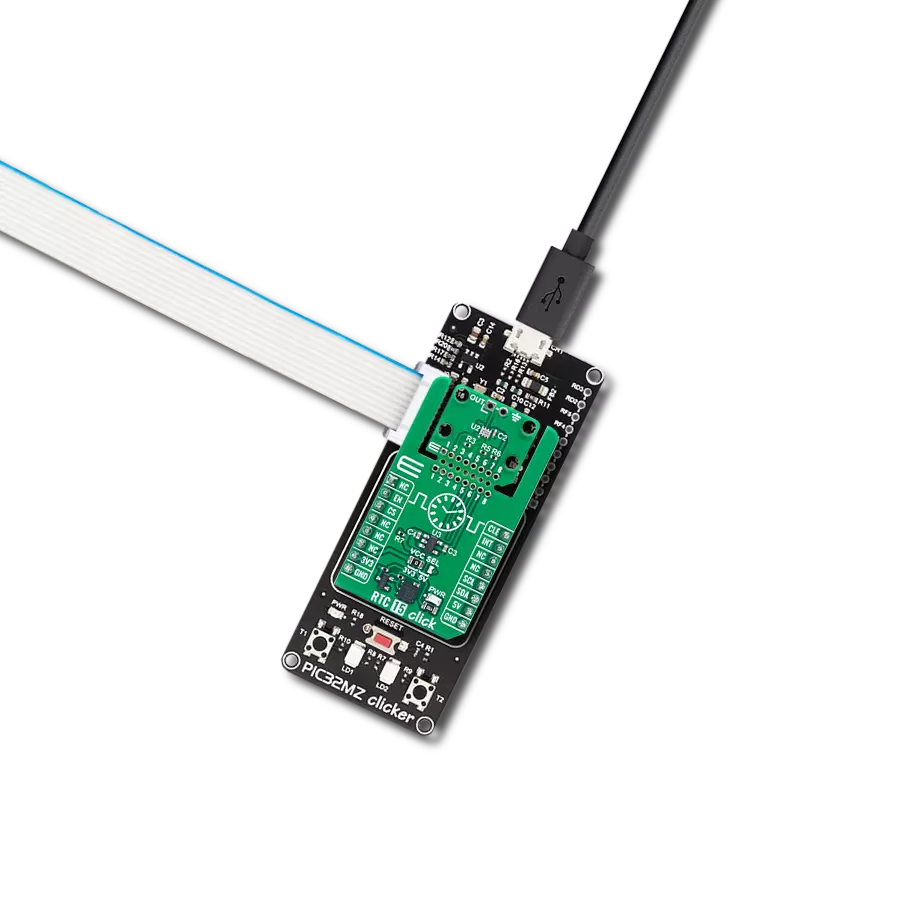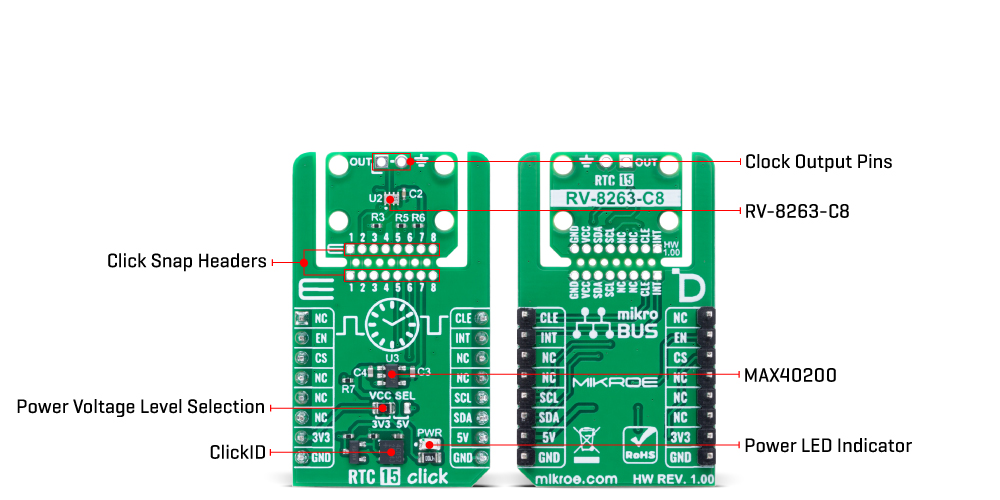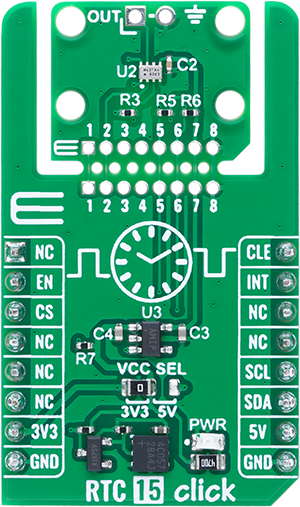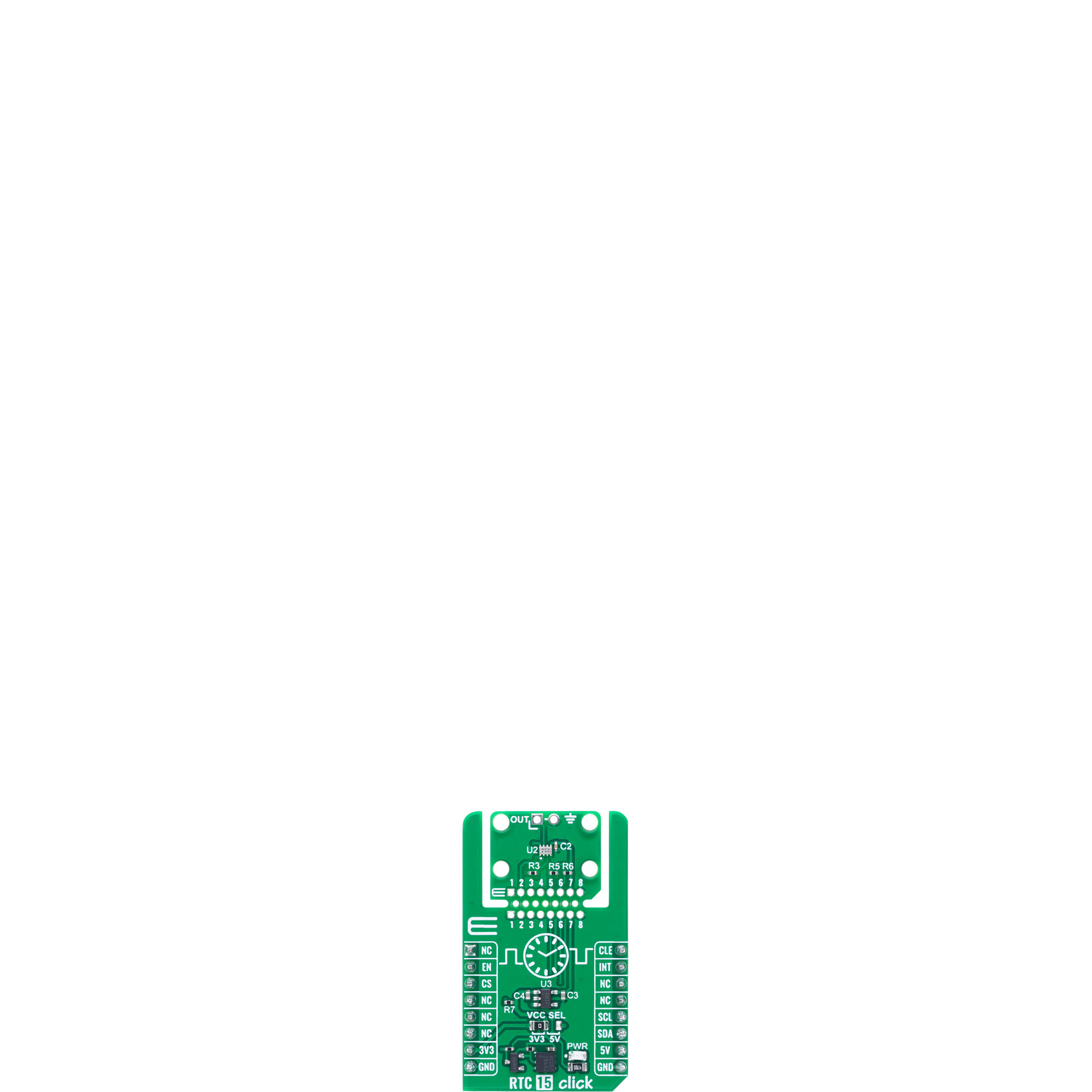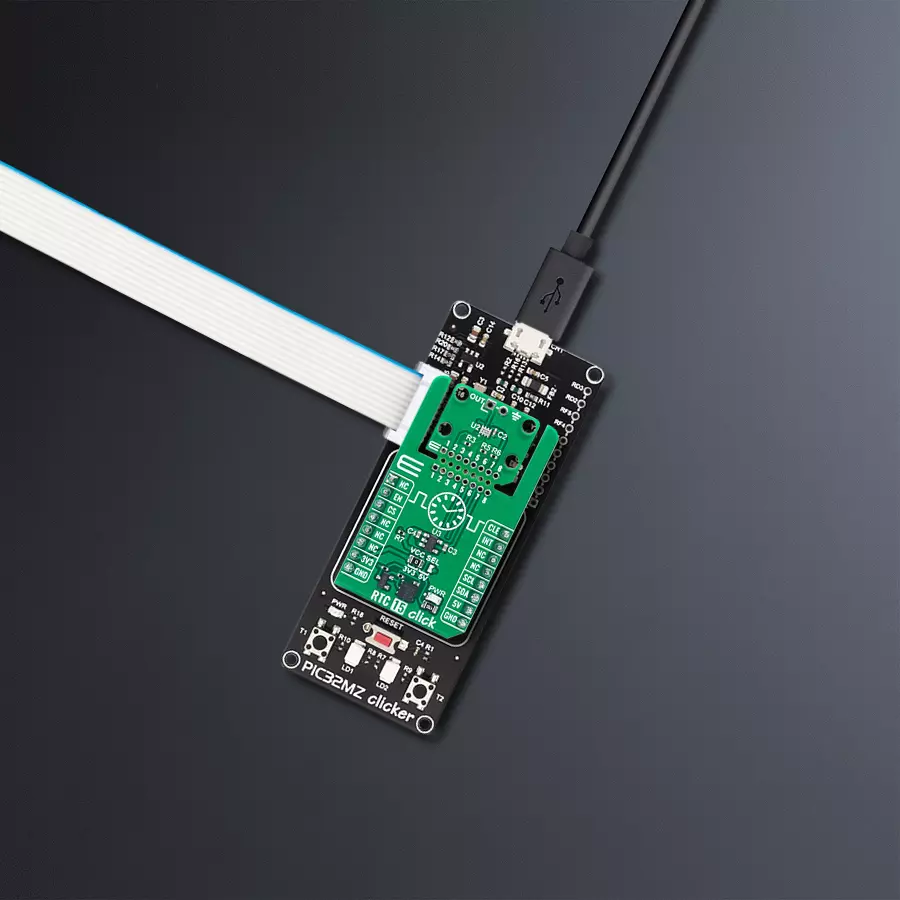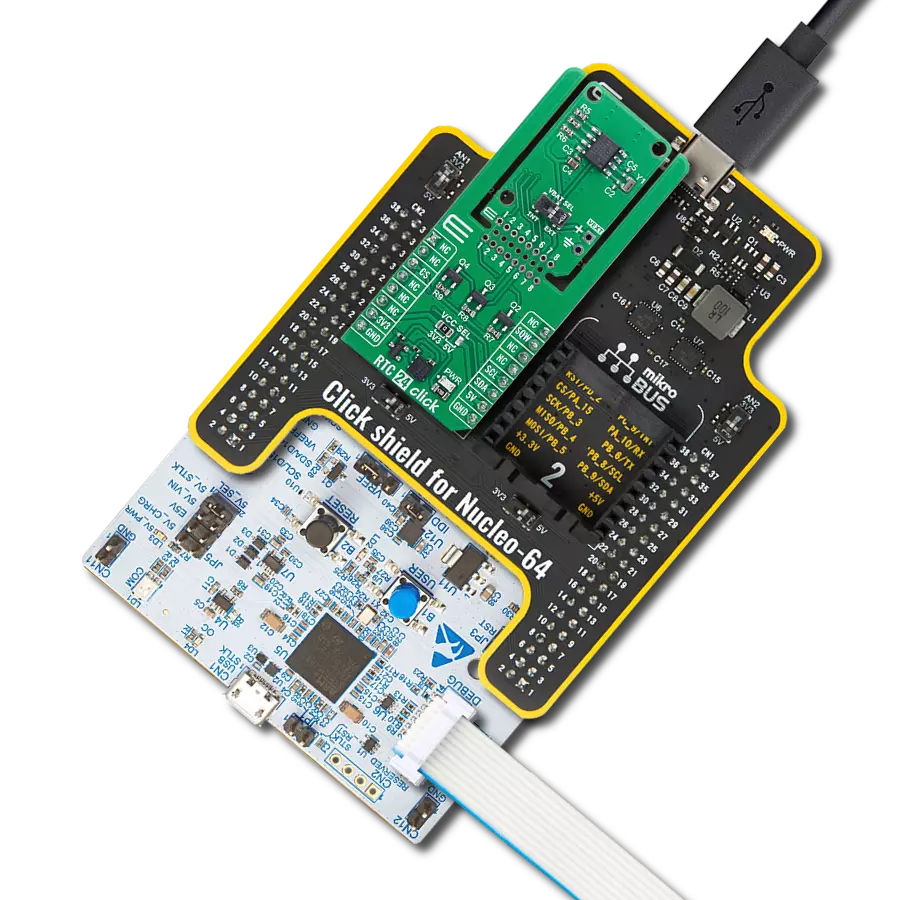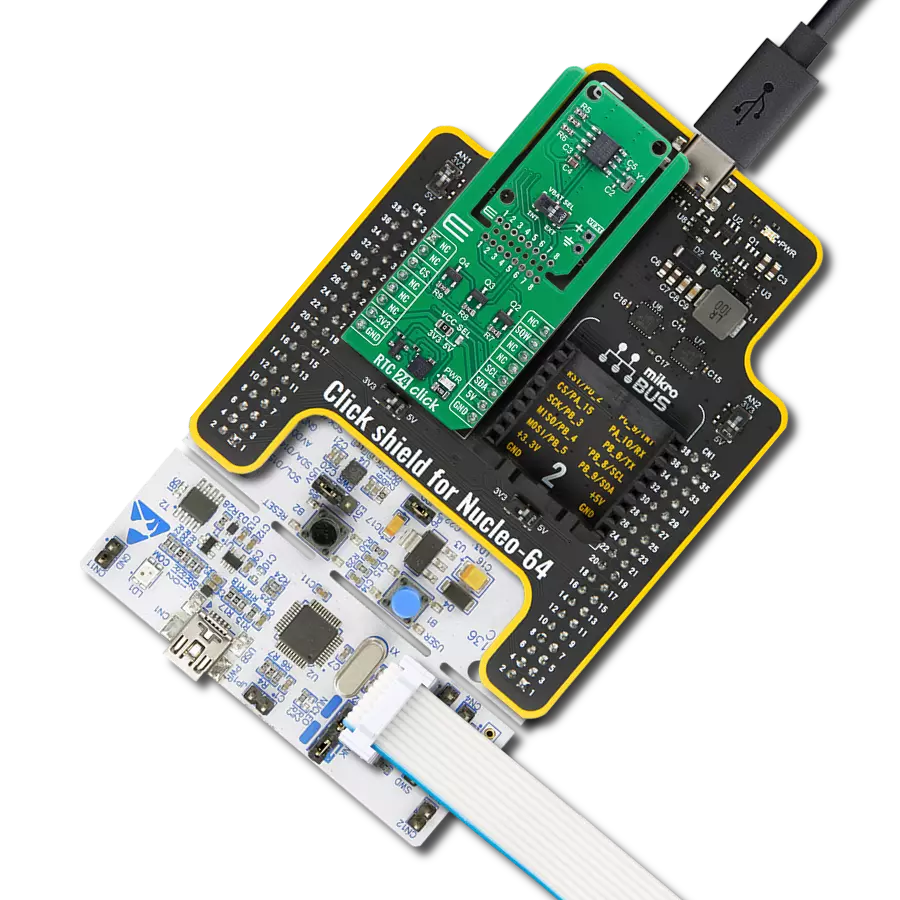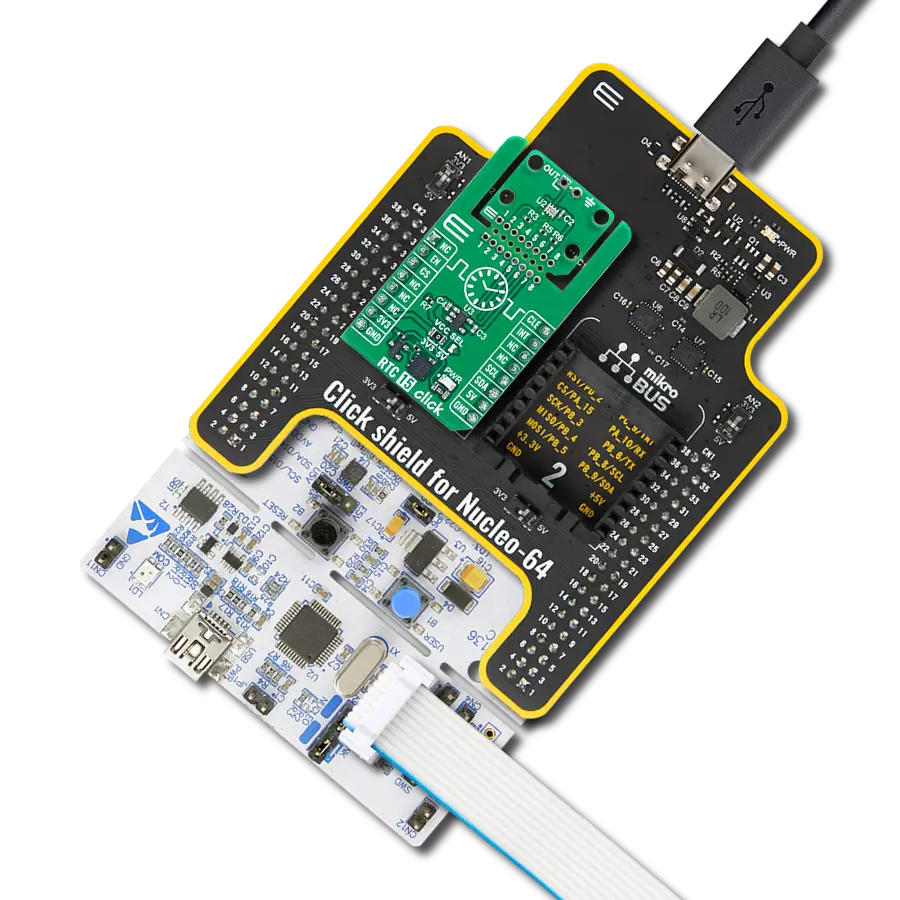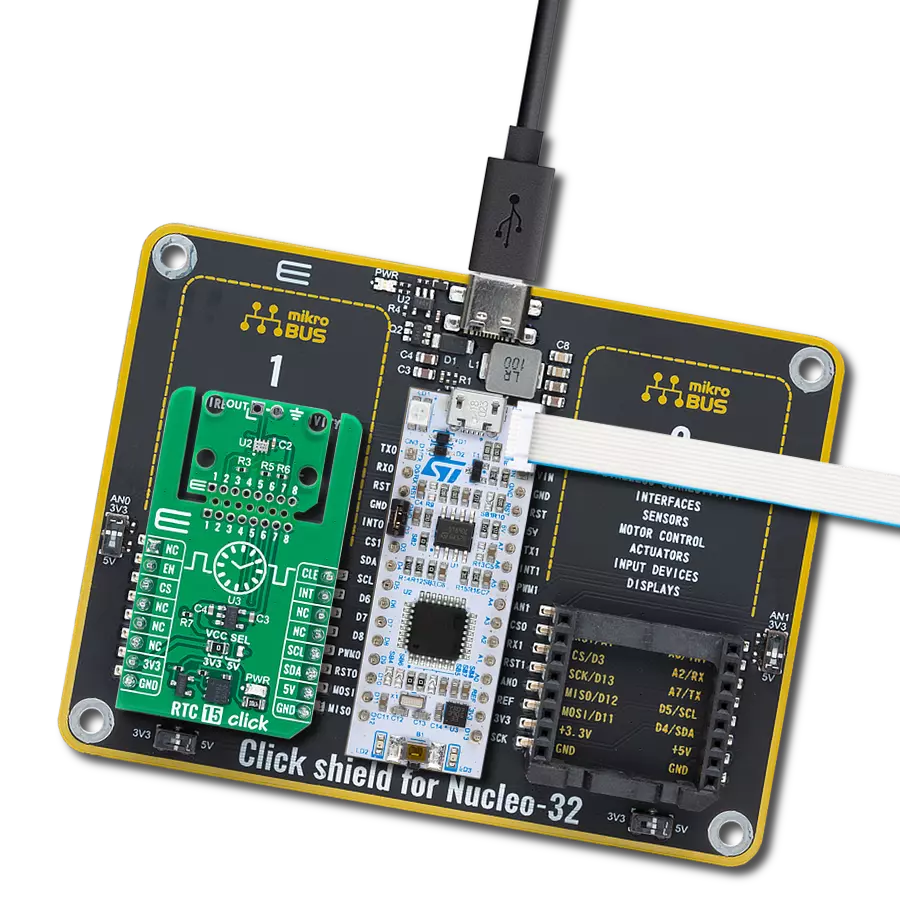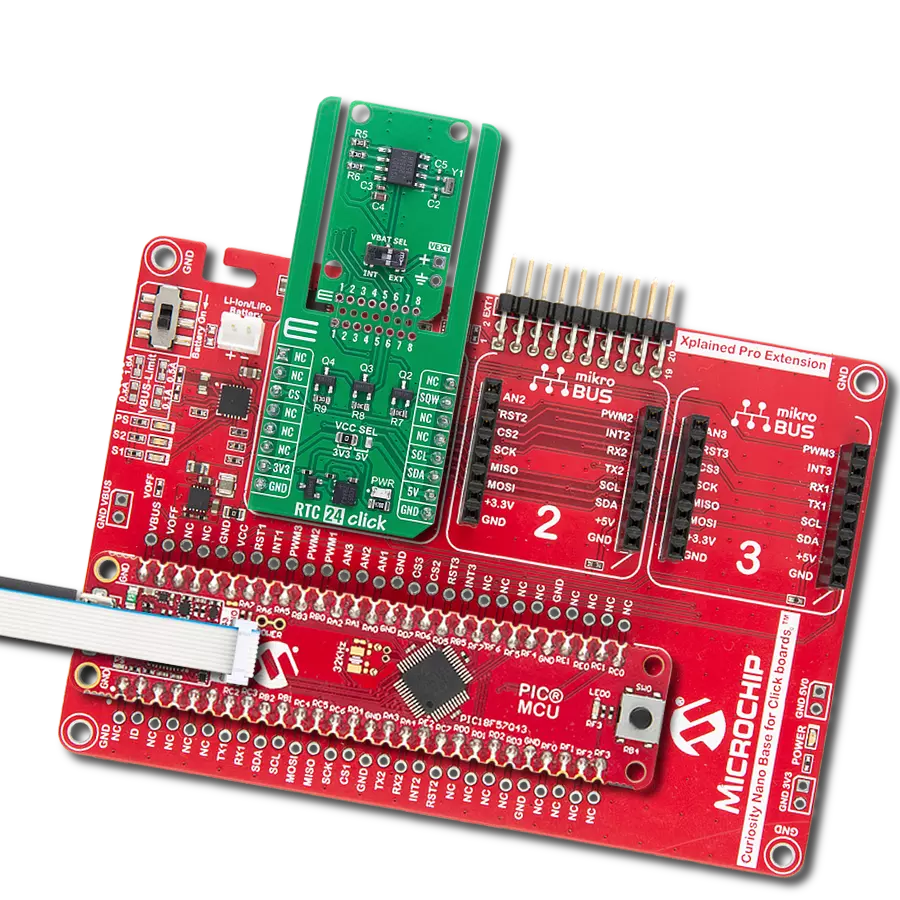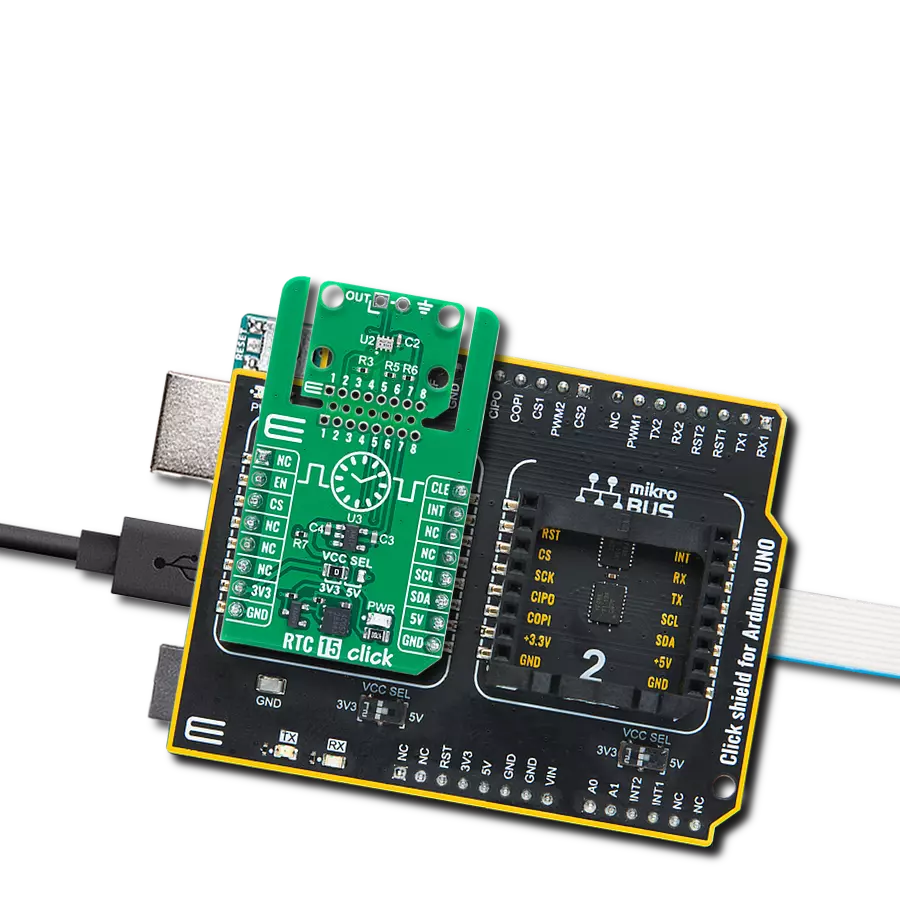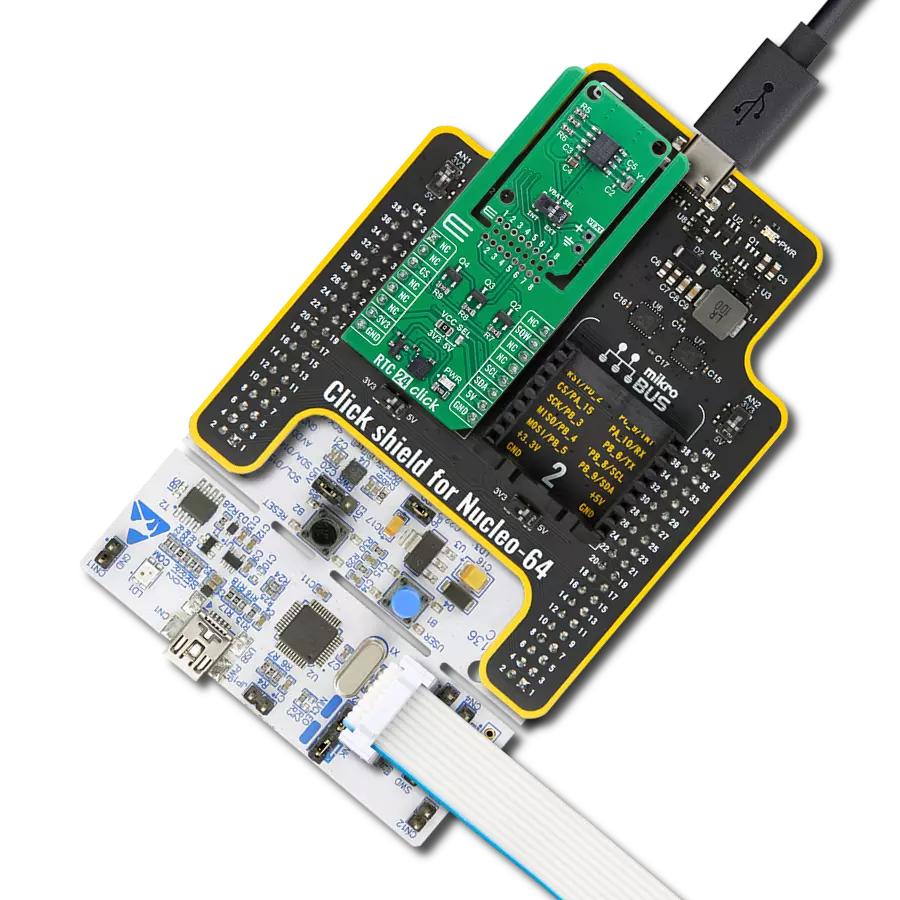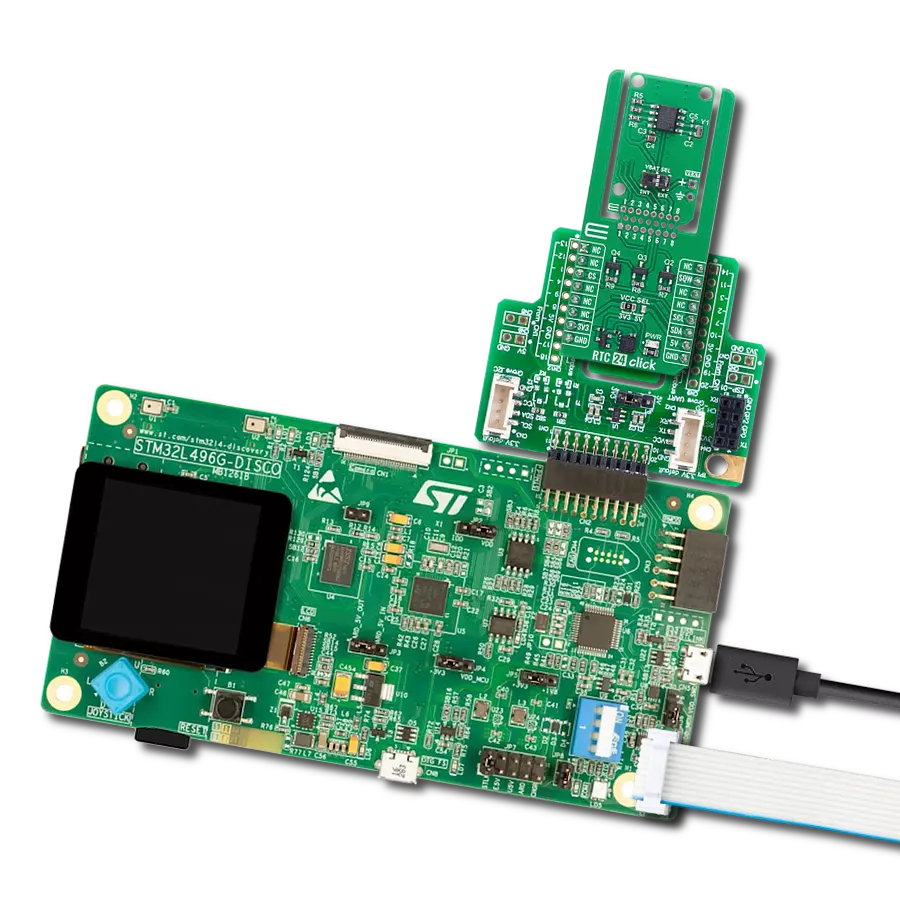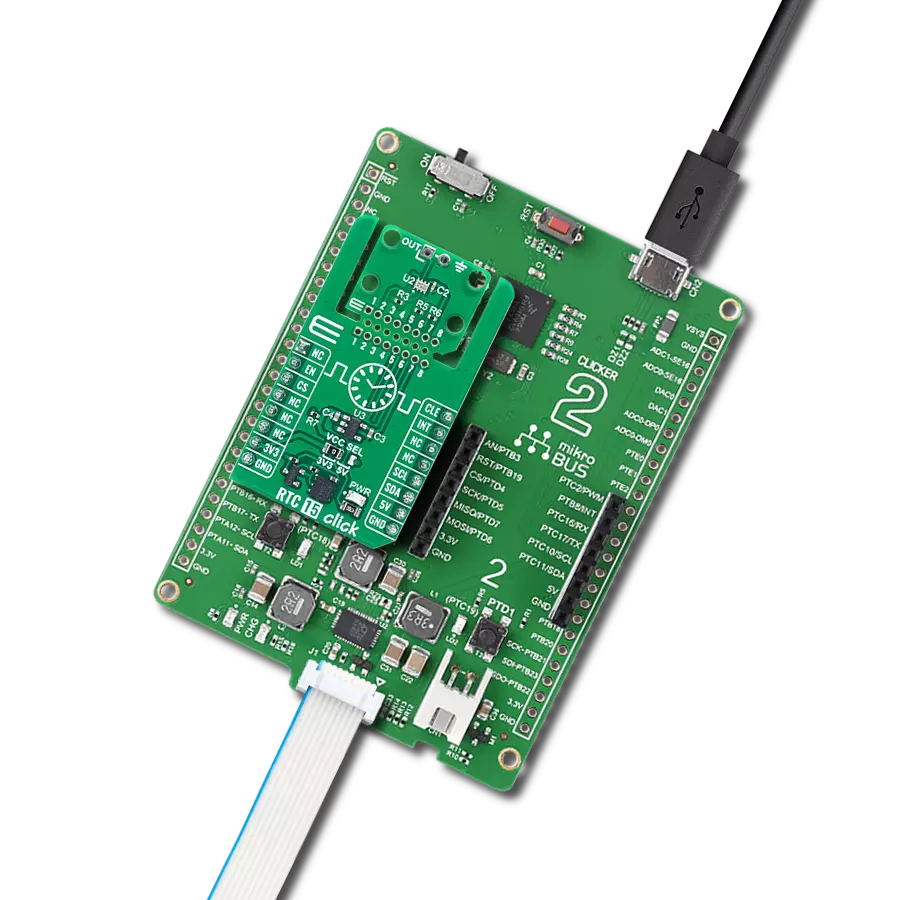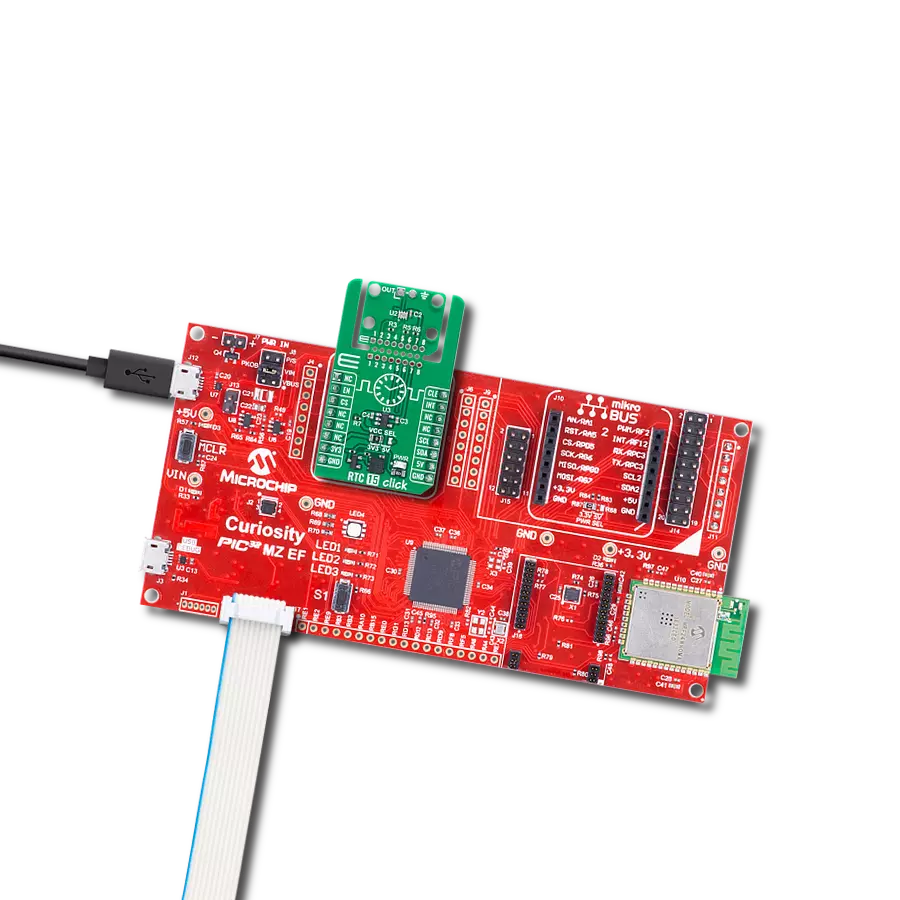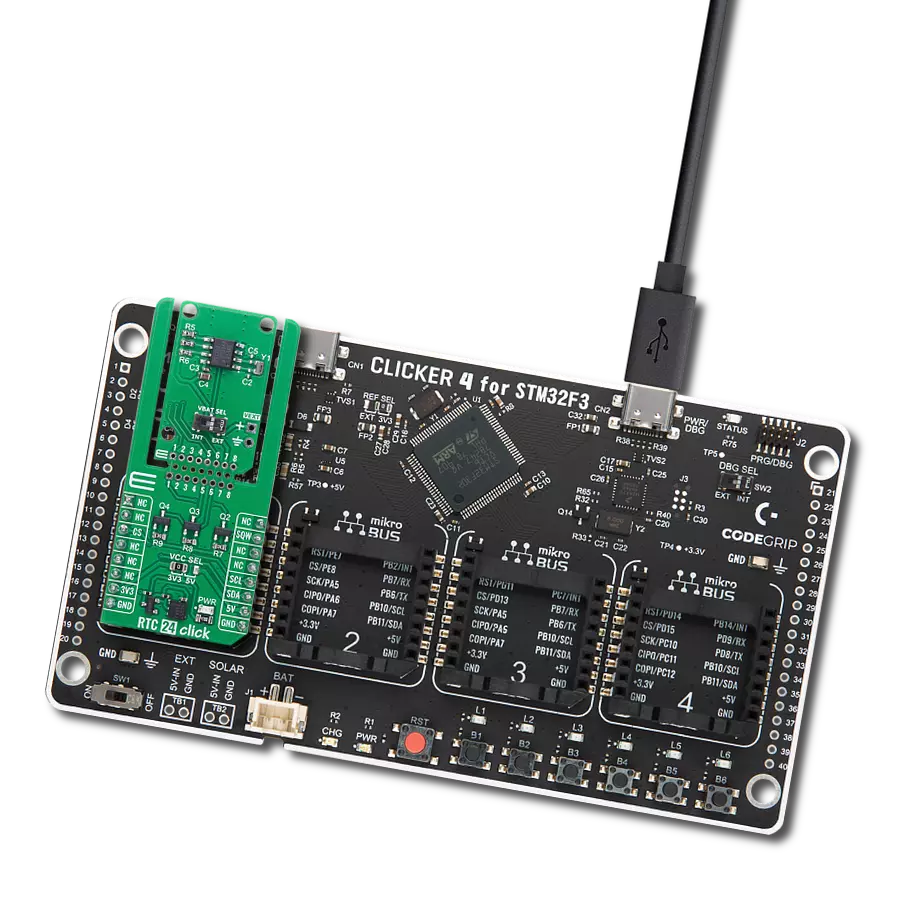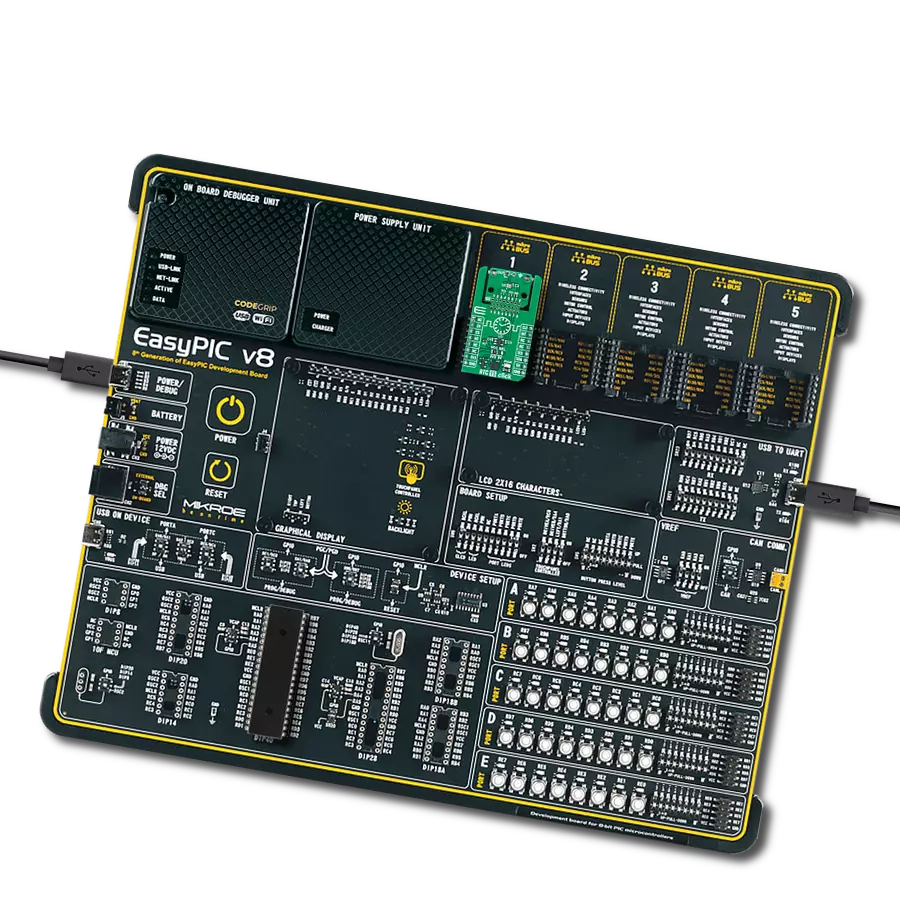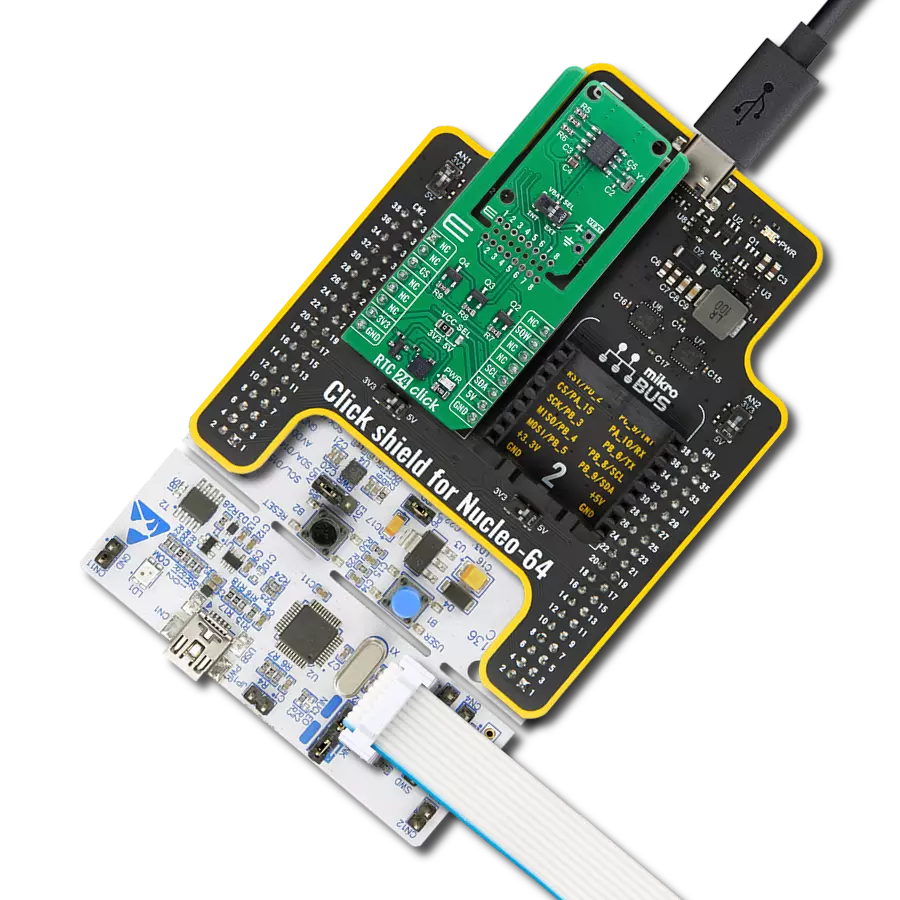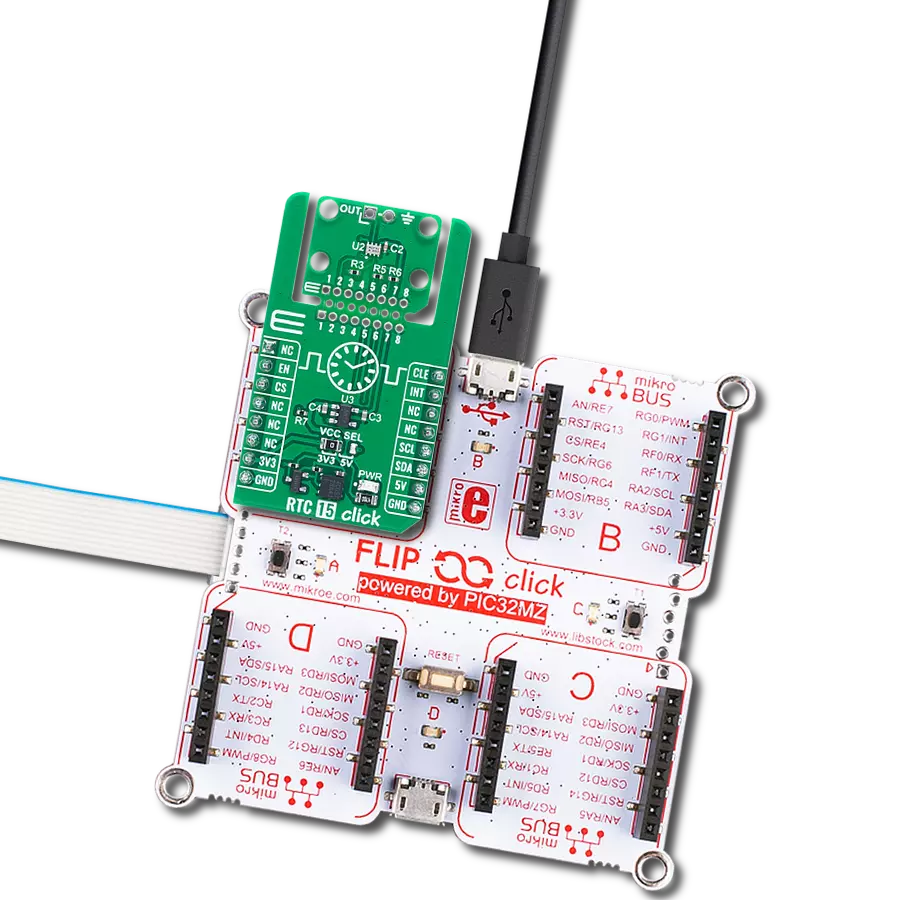Track precise time and date in embedded projects with ultra-low-power RTC module
A
A
Hardware Overview
How does it work?
RTC 15 Click is based on the RV-8263-C8, a standard commercial-grade real-time clock/calendar module from Micro Crystal, known for its low power consumption and high precision. This CMOS-based device operates with a 32.768kHz clock and includes an offset register that enables fine-tuning of frequency deviations, ensuring reliable timekeeping in long-term applications. Communication with the host MCU is handled via an I2C interface, with automatic register address incrementing after each data transfer for efficient access. Despite its ultra-small and lightweight design, the module offers full calendar functionality, including tracking of year, month, date, weekday, hours, minutes, and seconds, along with support for automatic leap year correction from 2000 to 2099. Additionally, it features built-in timer and alarm capabilities. The RTC 15 Click is ideal for use in IoT systems, industrial and automotive applications, metering solutions, healthcare devices, as well as wearable and portable electronics. RTC 15 Click is designed
in a unique format supporting the newly introduced MIKROE feature called "Click Snap." Unlike the standardized version of Click boards, this feature allows the main sensor area to become movable by breaking the PCB, opening up many new possibilities for implementation. Thanks to the Snap feature, the RV-8263-C8 can operate autonomously by accessing their signals directly on the pins marked 1-8. Additionally, the Snap part includes a specified and fixed screw hole position, enabling users to secure the Snap board in their desired location. This Click board™ uses an I2C interface with clock speeds of up to 400kHz, ensuring fast communication with the host MCU. In addition to the I2C interface pins, RTC 15 Click features an EN pin used to control the MAX40200 ideal diode, which in this design acts as a power switch, and INT pin as interrupt used to output alarm, minute, half minute, countdown timer and compensation Interrupt signals. When the EN pin is activated, it enables the MAX40200 to supply power to sensor on the board. This setup allows power management
by enabling or disabling the sensor as needed, making it especially useful for low-power and battery-operated applications. RTC 15 Click also includes unsoldered OUT pins that can be used for clock signal output, controlled by the CLE pin. When the CLE pin is set HIGH, the OUT pin generates a selectable square wave output with available frequencies of 32.768kHz (default), 16.384kHz, 8.192kHz, 4.096kHz, 2.048kHz, 1.024kHz, or 1Hz, offering flexibility for various timing requirements. If the CLE pin is held LOW, the OUT pin remains LOW, effectively disabling the clock output. This Click board™ can operate with either 3.3V or 5V logic voltage levels selected via the VCC SEL jumper. This way, both 3.3V and 5V capable MCUs can use the communication lines properly. Also, this Click board™ comes equipped with a library containing easy-to-use functions and an example code that can be used as a reference for further development.
Features overview
Development board
PIC32MZ Clicker is a compact starter development board that brings the flexibility of add-on Click boards™ to your favorite microcontroller, making it a perfect starter kit for implementing your ideas. It comes with an onboard 32-bit PIC32MZ microcontroller with FPU from Microchip, a USB connector, LED indicators, buttons, a mikroProg connector, and a header for interfacing with external electronics. Thanks to its compact design with clear and easy-recognizable silkscreen markings, it provides a fluid and immersive working experience, allowing access anywhere and under
any circumstances. Each part of the PIC32MZ Clicker development kit contains the components necessary for the most efficient operation of the same board. In addition to the possibility of choosing the PIC32MZ Clicker programming method, using USB HID mikroBootloader, or through an external mikroProg connector for PIC, dsPIC, or PIC32 programmer, the Clicker board also includes a clean and regulated power supply module for the development kit. The USB Micro-B connection can provide up to 500mA of current, which is more than enough to operate all onboard
and additional modules. All communication methods that mikroBUS™ itself supports are on this board, including the well-established mikroBUS™ socket, reset button, and several buttons and LED indicators. PIC32MZ Clicker is an integral part of the Mikroe ecosystem, allowing you to create a new application in minutes. Natively supported by Mikroe software tools, it covers many aspects of prototyping thanks to a considerable number of different Click boards™ (over a thousand boards), the number of which is growing every day.
Microcontroller Overview
MCU Card / MCU
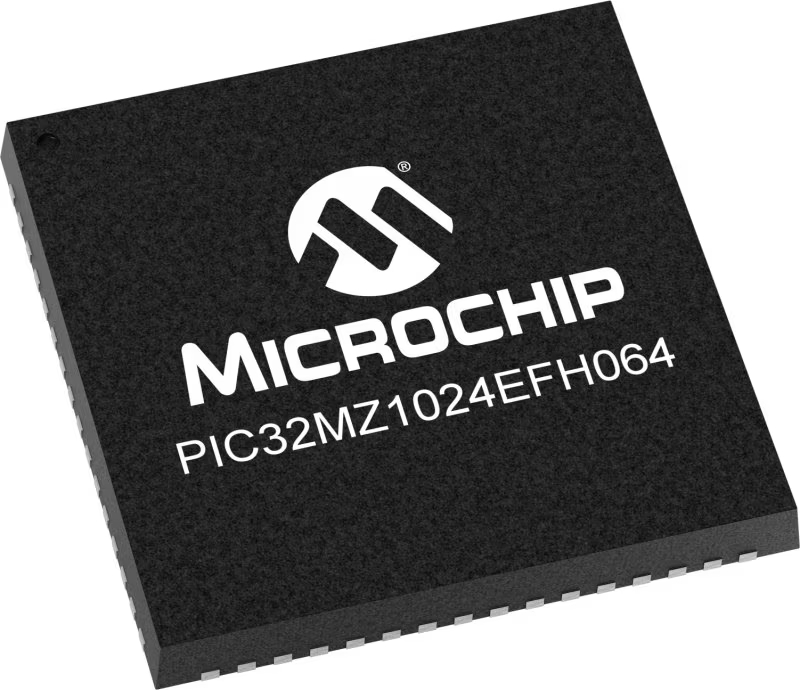
Architecture
PIC32
MCU Memory (KB)
1024
Silicon Vendor
Microchip
Pin count
64
RAM (Bytes)
524288
Used MCU Pins
mikroBUS™ mapper
Take a closer look
Click board™ Schematic
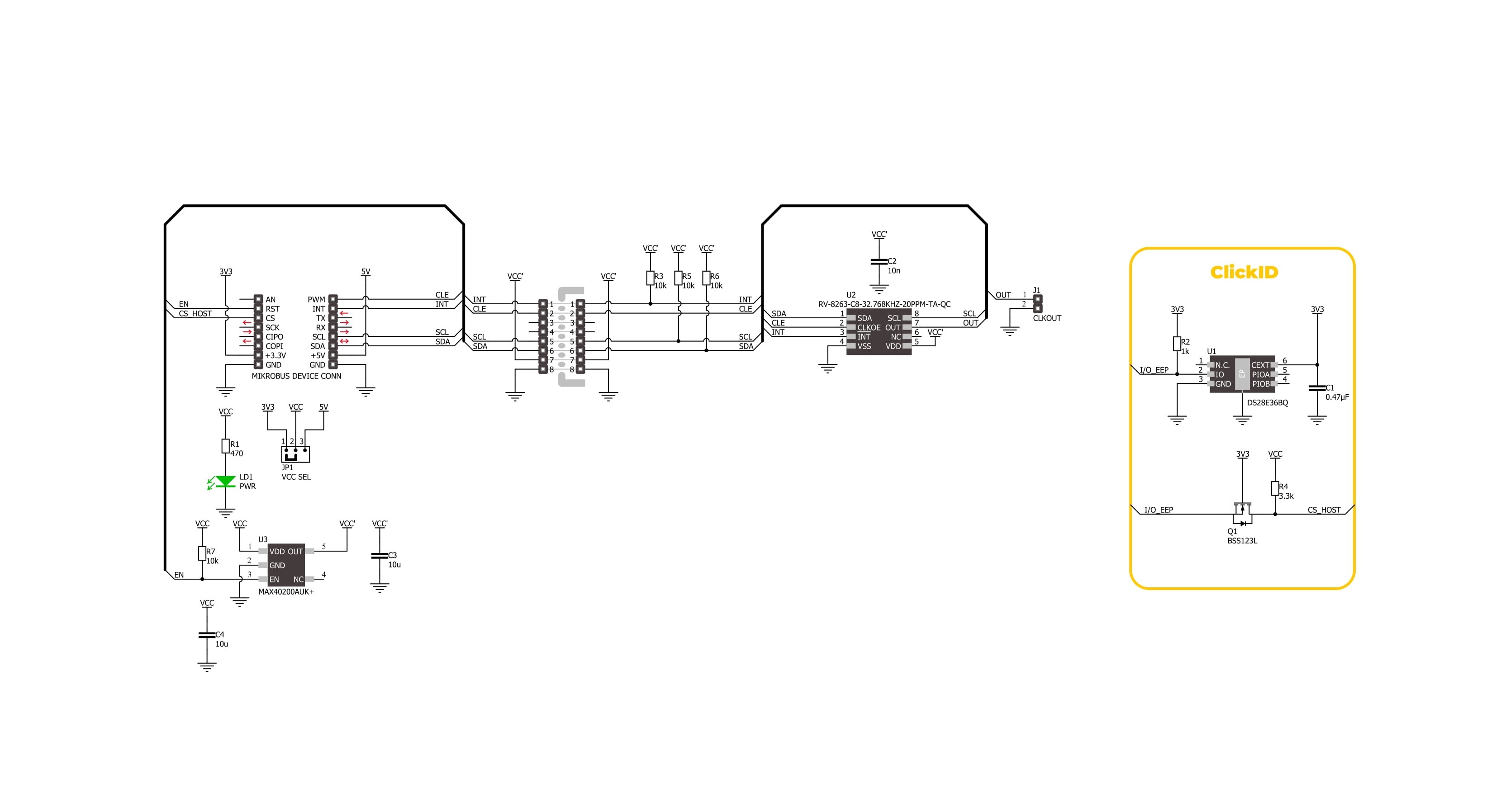
Step by step
Project assembly
Track your results in real time
Application Output
1. Application Output - In Debug mode, the 'Application Output' window enables real-time data monitoring, offering direct insight into execution results. Ensure proper data display by configuring the environment correctly using the provided tutorial.

2. UART Terminal - Use the UART Terminal to monitor data transmission via a USB to UART converter, allowing direct communication between the Click board™ and your development system. Configure the baud rate and other serial settings according to your project's requirements to ensure proper functionality. For step-by-step setup instructions, refer to the provided tutorial.

3. Plot Output - The Plot feature offers a powerful way to visualize real-time sensor data, enabling trend analysis, debugging, and comparison of multiple data points. To set it up correctly, follow the provided tutorial, which includes a step-by-step example of using the Plot feature to display Click board™ readings. To use the Plot feature in your code, use the function: plot(*insert_graph_name*, variable_name);. This is a general format, and it is up to the user to replace 'insert_graph_name' with the actual graph name and 'variable_name' with the parameter to be displayed.

Software Support
Library Description
RTC 15 Click demo application is developed using the NECTO Studio, ensuring compatibility with mikroSDK's open-source libraries and tools. Designed for plug-and-play implementation and testing, the demo is fully compatible with all development, starter, and mikromedia boards featuring a mikroBUS™ socket.
Example Description
This example demonstrates the use of the RTC 15 Click board by initializing the device and setting up the current time and date. It continuously reads and displays the updated time and date every second using the timer countdown interrupt pin.
Key functions:
rtc15_cfg_setup- This function initializes Click configuration structure to initial values.rtc15_init- This function initializes all necessary pins and peripherals used for this Click board.rtc15_default_cfg- This function executes a default configuration of RTC 15 Click board.rtc15_set_time- This function sets the current time (hours, minutes, seconds) in the RTC.rtc15_read_time- This function reads the current time (hours, minutes, seconds) from the RTC.rtc15_read_date- This function reads the current date (day, day of week, month, year) from the RTC.
Application Init
Initializes the logger and the RTC 15 Click driver, applies the default configuration, and sets the starting time and date.
Application Task
Waits for a 1 Hz interrupt signal and then reads and displays the current time and date.
Open Source
Code example
The complete application code and a ready-to-use project are available through the NECTO Studio Package Manager for direct installation in the NECTO Studio. The application code can also be found on the MIKROE GitHub account.
/*!
* @file main.c
* @brief RTC 15 Click example
*
* # Description
* This example demonstrates the use of the RTC 15 Click board by initializing
* the device and setting up the current time and date. It continuously
* reads and displays the updated time and date every second using the timer
* countdown interrupt pin.
*
* The demo application is composed of two sections:
*
* ## Application Init
* Initializes the logger and the RTC 15 Click driver, applies the default configuration,
* and sets the starting time and date.
*
* ## Application Task
* Waits for a 1 Hz interrupt signal and then reads and displays the current time and date.
*
* @author Stefan Filipovic
*
*/
#include "board.h"
#include "log.h"
#include "rtc15.h"
static rtc15_t rtc15;
static log_t logger;
static rtc15_time_t time;
static rtc15_date_t date;
/**
* @brief RTC 15 get day of week name function.
* @details This function returns the name of day of the week as a string.
* @param[in] ctx : Click context object.
* See #rtc15_t object definition for detailed explanation.
* @param[in] day_of_week : Day of week decimal value.
* @return Name of day as a string.
* @note None.
*/
static uint8_t *rtc15_get_day_of_week_name ( uint8_t day_of_week );
void application_init ( void )
{
log_cfg_t log_cfg; /**< Logger config object. */
rtc15_cfg_t rtc15_cfg; /**< Click config object. */
/**
* Logger initialization.
* Default baud rate: 115200
* Default log level: LOG_LEVEL_DEBUG
* @note If USB_UART_RX and USB_UART_TX
* are defined as HAL_PIN_NC, you will
* need to define them manually for log to work.
* See @b LOG_MAP_USB_UART macro definition for detailed explanation.
*/
LOG_MAP_USB_UART( log_cfg );
log_init( &logger, &log_cfg );
log_info( &logger, " Application Init " );
// Click initialization.
rtc15_cfg_setup( &rtc15_cfg );
RTC15_MAP_MIKROBUS( rtc15_cfg, MIKROBUS_1 );
if ( I2C_MASTER_ERROR == rtc15_init( &rtc15, &rtc15_cfg ) )
{
log_error( &logger, " Communication init." );
for ( ; ; );
}
if ( RTC15_ERROR == rtc15_default_cfg ( &rtc15 ) )
{
log_error( &logger, " Default configuration." );
for ( ; ; );
}
time.hour = 23;
time.minute = 59;
time.second = 50;
if ( RTC15_OK == rtc15_set_time ( &rtc15, &time ) )
{
log_printf( &logger, " Set time: %.2u:%.2u:%.2u\r\n",
( uint16_t ) time.hour, ( uint16_t ) time.minute, ( uint16_t ) time.second );
}
date.day_of_week = RTC15_TUESDAY;
date.day = 31;
date.month = 12;
date.year = 24;
if ( RTC15_OK == rtc15_set_date ( &rtc15, &date ) )
{
log_printf( &logger, " Set date: %s, %.2u.%.2u.20%.2u.\r\n",
rtc15_get_day_of_week_name ( date.day_of_week ),
( uint16_t ) date.day, ( uint16_t ) date.month, ( uint16_t ) date.year );
}
log_info( &logger, " Application Task " );
}
void application_task ( void )
{
// Wait for a timer countdown flag configured at 1 Hz
while ( rtc15_get_int_pin ( &rtc15 ) );
if ( RTC15_OK == rtc15_read_time ( &rtc15, &time ) )
{
log_printf( &logger, " Time: %.2u:%.2u:%.2u\r\n",
( uint16_t ) time.hour, ( uint16_t ) time.minute, ( uint16_t ) time.second );
}
if ( RTC15_OK == rtc15_read_date ( &rtc15, &date ) )
{
log_printf( &logger, " Date: %s, %.2u.%.2u.20%.2u.\r\n\n",
rtc15_get_day_of_week_name ( date.day_of_week ),
( uint16_t ) date.day, ( uint16_t ) date.month, ( uint16_t ) date.year );
}
Delay_ms ( 100 );
}
int main ( void )
{
/* Do not remove this line or clock might not be set correctly. */
#ifdef PREINIT_SUPPORTED
preinit();
#endif
application_init( );
for ( ; ; )
{
application_task( );
}
return 0;
}
static uint8_t *rtc15_get_day_of_week_name ( uint8_t day_of_week )
{
switch ( day_of_week )
{
case RTC15_MONDAY:
{
return "Monday";
}
case RTC15_TUESDAY:
{
return "Tuesday";
}
case RTC15_WEDNESDAY:
{
return "Wednesday";
}
case RTC15_THURSDAY:
{
return "Thursday";
}
case RTC15_FRIDAY:
{
return "Friday";
}
case RTC15_SATURDAY:
{
return "Saturday";
}
case RTC15_SUNDAY:
{
return "Sunday";
}
default:
{
return "Unknown";
}
}
}
// ------------------------------------------------------------------------ END
